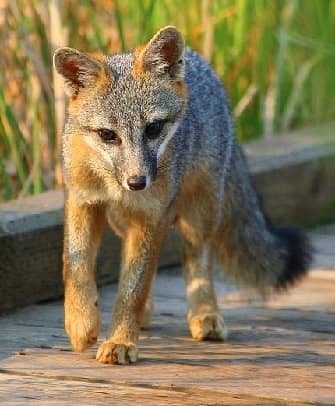Introduction - Grey Fox
The Grey Fox, also known as a Tree Fox or Gray Fox, is a nocturnal mammal who can be found throughout many areas of the United States. They can be found as far north as Canada and as far south as South America. They are most likely to be found living in deciduous forest areas or areas with thick brush, swamp areas and thickets. What makes this animal unique is that it is one of the only members of the dog family that has the ability to climb trees. They are so agile in trees that when they climb down, they can go either head or tail first. Read the list of facts below for more information on their tree climbing abilities, why they are often confused with the Red Fox and much more. This information is written for both kids and adults.Click here for a great selection of Amazon.com books about Foxes.
List of Grey Fox Facts
- People tend to confuse the Grey Fox with the Red Fox mainly because of the reddish-brown fur over much of its body including its ears, neck, chest, feet, and parts of the legs and belly. They are also similar in size.
- The average lifespan of a Grey Fox in the wild is 6 - 10 years.
- The Grey Fox looks similar to a small dog with its long snout and pointy ears but it has a much bushier tail which is usually pointed straight out. Its coat is mostly grey with some reddish brown areas, some white areas, and a black tip on the tail. Its legs are relatively short and stout.
- Both male and females usually weigh between 8 - 15 pounds (3.6 to 7 kg). The total body length ranges from 30 - 44 inches (76 to 112.5 cm).
- The diet varies slightly depending on the region, but the Grey Fox is considered an omnivore. Prey includes rabbits, mice, voles, birds and insects. The Grey Fox also ingests a healthy potion of fruits and vegetables.
Grey Fox Tree Climbing Facts
- The Grey Fox can climb any type of tree. Straight trees with little or no bend to them are no problem for the Grey Fox.
- It has very strong, non-retractable claws that are hooked to help it grab onto trees.
- They climb trees for several reasons. Climbing trees allows them to escape from predators and also allows them to catch prey. They also enjoy being up in a tree for a nap in a sunny spot. Although unusual, they have also been known to use a hollow tree as a den to raise a litter well above ground level.
Grey Fox Reproduction Facts
- The peak breeding period for Grey Foxes is in early March but the breeding season lasts from January through May.
- Litter size ranges from 1 - 7 pups with 3 or 4 pups being most common.
- The gestation period ranges anywhere from 51-63 days.
- The pups live with their parents in above ground dens which might be a tree hole, brush that has been clustered together, rock formations, or even underneath man-made barns or garages. The pups do not come out of the den until they are about 5 weeks old.
- At 3 months of age, the pups will begin learning how to hunt and catch their own food.
- By the fall the pups set out on their own in preparation to breed and raise their own litters by the next breeding season.
